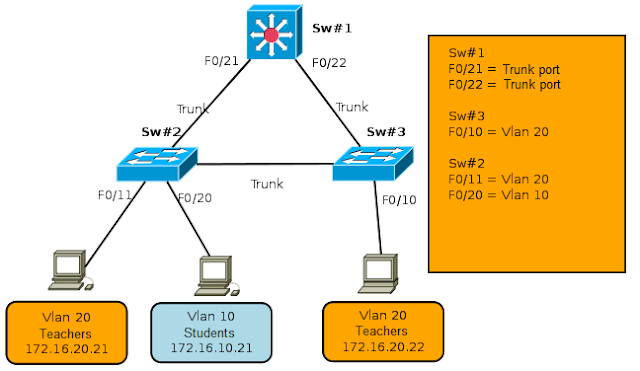Routing between VLANs with Layer 3 Cisco Switches
Once you have the knowledge to configure the network using VLAN, it is necessary for users of different logical subnets to communicate with each other. This requires use routing between VLANs.
There are many ways to perform inter-VLAN routing, such as:
This time will be described a bit about how to configure routing between VLANs with Layer 3 switches, using for this a Catalyst 3750G-24PS switch, one of many Cisco switches that support Layer 3 routing.

The icon that represents the Layer 3 switch is different from the icons to represent a Layer 2 switch. In order to understand how the Layer 3 switch routing process does need to know a little about Switches Virtual Interfaces or SVI, which is what really allows routing between VLANs.
SVI
SVI is a logical interface configured for a specific VLAN. You need to configure an SVI for a VLAN if you want to route between VLANs. By default, an SVI is created for the default VLAN (VLAN 1) to permit remote switch administration.
Layer 3 Forwarding
A Layer 3 switch is capable of routing packets between VLANs. The procedure is the same as is used with a router, except that SVI act as router interfaces to route data between VLANs.

Configuring Interfaces (SVI)
The interface configuration is very simple, is similar to the configuration of the interface vlan 1, except that you must specify the vlan ID. A sample configuration for configuring the SVI interface Vlan 10.
Similarly for each VLAN is desired route, you must perform routing between VLANs using Layer 3 switches, improves the performance of traditional approaches, because these devices have better performance routers.
The only thing not to forget is, that the IP address of the SVI interfaces is the default gateway of the devices within each VLAN. In the example, the default gateway of Computers belonging to VLAN 10, will be the 172.16.10.1 (virtual interface on the switch).
The VLAN routing scheme, using Layer 3 switches can be as simple as the example shown here, or as complex as making distribution of SVI interfaces between multiple switches, or implementing a routing protocol such as RIP , BGP or EIGRP, for sharing routes.
There are many ways to perform inter-VLAN routing, such as:
- Router on a Stick
- Traditional Routing
- Routing between VLANs with Linux Server
This time will be described a bit about how to configure routing between VLANs with Layer 3 switches, using for this a Catalyst 3750G-24PS switch, one of many Cisco switches that support Layer 3 routing.

The icon that represents the Layer 3 switch is different from the icons to represent a Layer 2 switch. In order to understand how the Layer 3 switch routing process does need to know a little about Switches Virtual Interfaces or SVI, which is what really allows routing between VLANs.
SVI
SVI is a logical interface configured for a specific VLAN. You need to configure an SVI for a VLAN if you want to route between VLANs. By default, an SVI is created for the default VLAN (VLAN 1) to permit remote switch administration.
Layer 3 Forwarding
A Layer 3 switch is capable of routing packets between VLANs. The procedure is the same as is used with a router, except that SVI act as router interfaces to route data between VLANs.

Configuring Interfaces (SVI)
The interface configuration is very simple, is similar to the configuration of the interface vlan 1, except that you must specify the vlan ID. A sample configuration for configuring the SVI interface Vlan 10.
SW1# configure terminal Sw1(config)# interface vlan 10 Sw1(config-subif)# ip address 172.16.10.1 255.255.255.0 Sw1(config-subif)# no shutdown
Similarly for each VLAN is desired route, you must perform routing between VLANs using Layer 3 switches, improves the performance of traditional approaches, because these devices have better performance routers.
The only thing not to forget is, that the IP address of the SVI interfaces is the default gateway of the devices within each VLAN. In the example, the default gateway of Computers belonging to VLAN 10, will be the 172.16.10.1 (virtual interface on the switch).
The VLAN routing scheme, using Layer 3 switches can be as simple as the example shown here, or as complex as making distribution of SVI interfaces between multiple switches, or implementing a routing protocol such as RIP , BGP or EIGRP, for sharing routes.
0 Comments:
Post a Comment